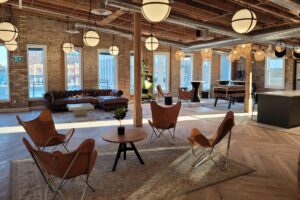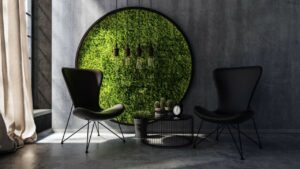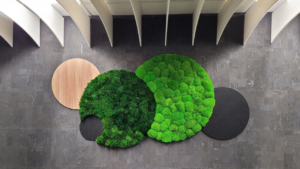For years, living walls have been popular in businesses and homes for their beauty and health attributes. They bring the outdoors indoors like few other design elements, help create calming environments and are natural air filters. They are eye-catching and functional with a sort of stately look and feel.
Living walls have been the dominant choice for nature-based features in homes and businesses for years. Slowly a new, more sustainable and cost-effective feature has emerged: moss walls. Both offer unique natural scenes with functional appeal. In this edition of the Acoustic Influencer, we dive into the eight reasons we recommend moss over living walls.
Acoustic Benefits
Not surprisingly, this is important to us — it’s why we do what we do — and moss is an excellent sound absorber. When coupled with acoustic walls and ceiling fixtures, it provides sound-deadening properties living walls simply don’t offer.
Aesthetics
Moss is a cool element that can be dyed to adapt to the space it is created for and make it feel like it belongs, not just an afterthought. It offers a unique and contemporary aesthetic, with biophilic properties that enhance the overall look and feel of a space.
Budget
Moss is more cost-effective than living walls while still adding natural elements to a space. It also doesn’t have the ongoing expenses associated with living plants.
Durability
Moss features need zero maintenance whereas living walls require frequent upkeep – new plants, bug repellent – and are susceptible to water leaks, which can damage its surroundings.
Environment
Moss is sustainable and can be harvested and preserved without harming the environment. Maintaining a living wall with live plants requires many more resources and has energy costs.
Health
Some people are allergic to plants or soil, to say nothing of the pests that tend to like living walls. Moss provides the same positive mental health and biophilic properties without any of the potential negative side effects.
Maintenance
Once moss is installed it doesn’t need any upkeep. Living walls require watering, feeding, pruning and constant maintenance.
Space Constraints
Moss can be applied to walls and ceilings, making it best for areas of limited size. Living walls require more floor space and vertical support structures.
Final Thoughts
There’s no doubt that living walls are beautiful and are a calming and relaxing entity. In our specialty industry where the focus is on quiet design elements, moss is the clear choice for the reasons above. If you agree or disagree, please leave a comment for discussion.
The Acoustic Influencer is specialized and focused, but we’re open to exploring any industry topics you’d like to read about. Let us know what those are, and we’ll do our best to examine them.





